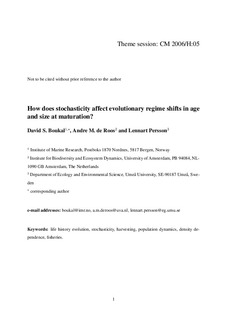How does stochasticity affect evolutionary regime shifts in age and size at maturation?
Abstract
Fish in many exploited stocks grow faster and mature earlier at either larger or smaller sizes
in comparison to pre-exploitation periods. These changes can be driven by both genetic and
phenotypic responses. We have shown recently that their interplay can lead to irreversible evolutionary
regime shifts in individual life histories and stock properties. Our results were based
on a model which assumed annual spawning and size- and density-dependent individual growth
in a deterministic environment. We now extend the analysis to cover stochasticity in recruitment,
survival after recruitment and harvesting pressure, including the possibility of bycatch
and illegal fishing after fishing moratoria or reduced harvest rates are imposed. We show that
under low and moderate stochasticity, early maturation at small sizes and late maturation at large
sizes can still persist as alternative, evolutionary and ecologically stable states under otherwise
identical environmental conditions. Typically, maturation sizes of the late-maturing phenotypes
decrease with increasing stochasticity, while those of the early-maturing phenotypes remain
nearly constant. Consequently, we confirm that even in stochastic environments, exploitation
of late-maturing populations can induce rapid evolution to smaller maturation sizes associated
with stepwise decreases in mean age at first reproduction. These changes can be reversed by
fishing moratoria; more stochastic environments and/or harvesting pressure require faster closure
of the fishery. Unless stochasticity is too strong, incomplete closure of the fishery may also
lead to the counterintuitive, accelerated evolution towards smaller sizes at maturation which we
reported for the deterministic system.
Publisher
ICESSeries
ICES CM documents2006/H:05
